Why Choose ContraVault AI for Tender Analysis?
ContraVault AI leverages AI in tendering to automate and optimize every step of the tender analysis process. From initial document review to risk assessment and Go/No-Go checks, it introduces a level of speed and precision unattainable with manual methods.
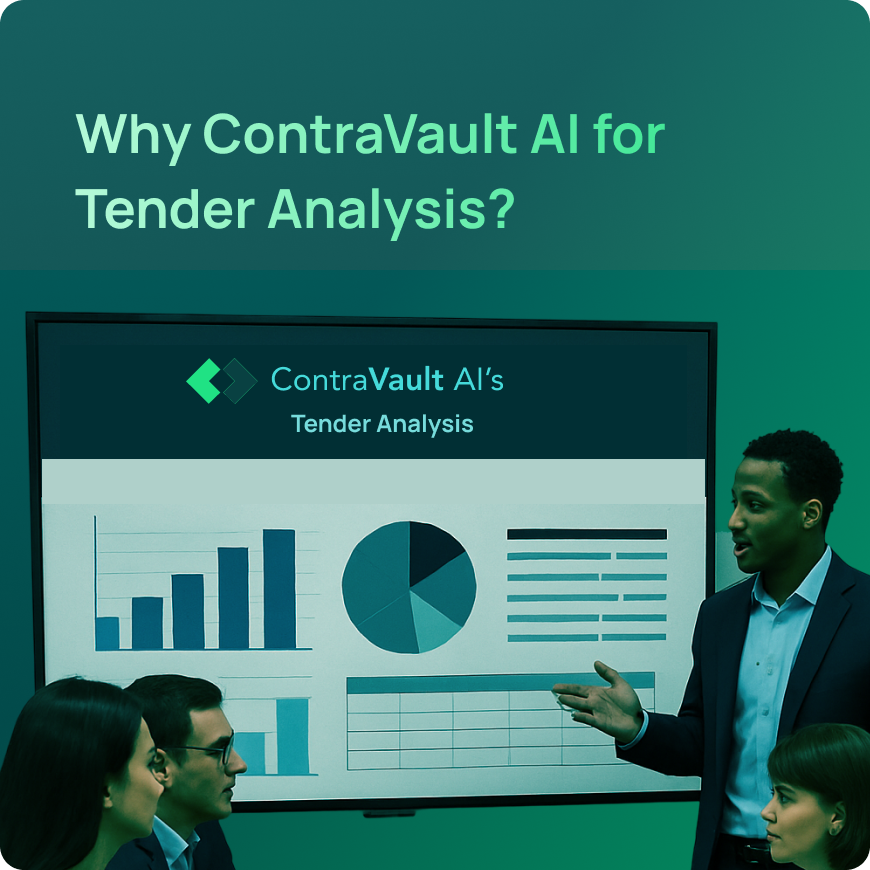
Introduction
Tenders – whether government contracts, construction bids, or large RFPs – are the lifeblood of many businesses. In India alone, public procurement accounts for nearly 30% of the country’s GDP, reflecting the massive scale and opportunity of Indian tenders. Yet managing these opportunities is no small feat. Bid teams often slog through voluminous documents (sometimes 1000+ pages long), painstakingly reading tenders line by line to extract requirements, risks, and compliance checkpoints. This manual process is time-consuming and prone to human error, which can result in missed opportunities and costly mistakes.
ContraVault AI leverages AI in tendering to automate and optimize every step of the tender analysis process. From initial document review to risk assessment and Go/No-Go checks, it introduces a level of speed and precision unattainable with manual methods. By harnessing advanced AI for tender analysis, businesses can respond faster, with greater accuracy and strategic insight, ultimately helping them win tenders more effectively. The following sections explore the current challenges in manual tendering and how ContraVault AI addresses them, followed by a deep dive into its key features and benefits for organizations, from global enterprises to companies aiming to win Indian tenders.
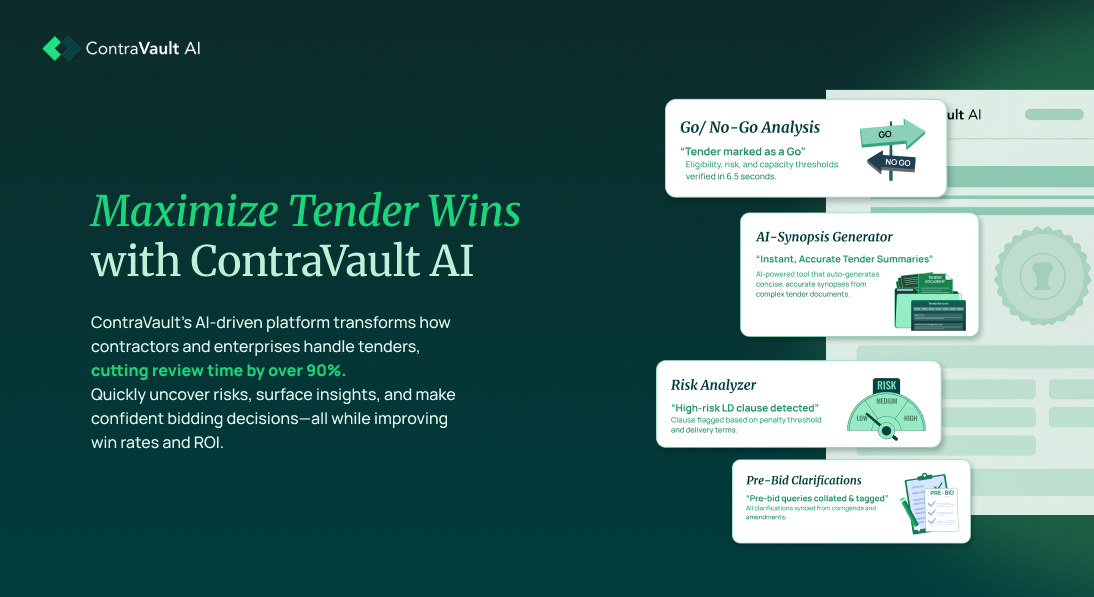
Current Challenges in Manual Tendering Processes
Despite the high stakes, many organizations still rely on manual tendering processes, which come with significant challenges:
Time-Intensive Reviews: Reviewing tender documents by hand is enormously time-consuming. It takes an average reader about 2 minutes per page, which adds up fast when tenders run into hundreds of pages. One study in Bangladesh found that preparing a tender manually took over 7.2 days on average, compared to about 2.8 days with an electronic process. This illustrates how manual teams can spend weeks just parsing documents, delaying bid decisions. In fast-paced markets (e.g., competitive infrastructure projects), such delays can mean missing submission deadlines or being outpaced by rivals.
Human Error and Oversight: Even the best teams are susceptible to oversight when faced with dense tender documents. Important clauses can be overlooked, and critical risks or contradictions can go undetected amid the volume. Manual data entry and form-filling are also error-prone – roughly 4 errors per 100 entries occur on average. These mistakes can be costly. For instance, a contradictory requirement buried in technical specs (e.g. one section allowing a deadline extension and another forbidding it) might slip through, leading to compliance issues later. Moreover, missed risks can translate into unaddressed liabilities or unanticipated costs in execution.
Difficulty in Compliance Checks: Tenders come with strict compliance and eligibility criteria. Ensuring every requirement is met – from technical specifications to paperwork – is cumbersome under tight timelines. It’s no surprise that nearly 20–30% of bids in India are rejected due to compliance issues alone. In highly regulated sectors (defense, railways, oil & gas, etc.), even minor deviations can result in immediate disqualification. Manual processes struggle to cross-check every clause against a list of criteria or regulations, meaning businesses risk disqualification or legal complications if something is missed.
Inefficient Extraction of Form Data: Many tender documents include numerous forms, annexures, and templates that bidders must fill out (pricing tables, technical questionnaires, etc.). Extracting data from these forms manually – and then re-entering it into internal spreadsheets or systems – wastes precious effort and is prone to errors. This duplication of work not only costs time but can lead to inconsistencies (e.g., a figure transposed incorrectly). Such inefficiencies add up; employees lose productivity when juggling multiple documents and tools. In fact, context-switching between tasks and tools (like going from a PDF tender to Excel for data entry) can consume about 9% of work time (five weeks per year). Manual form extraction epitomizes this inefficiency, pulling staff away from higher-value activities like strategy or vendor engagement.
These challenges highlight why traditional tender management often results in missed risks, compliance slip-ups, and suboptimal bid decisions. The cost is not just time, but potentially lost contracts and revenue. Thankfully, emerging technologies are changing the game.
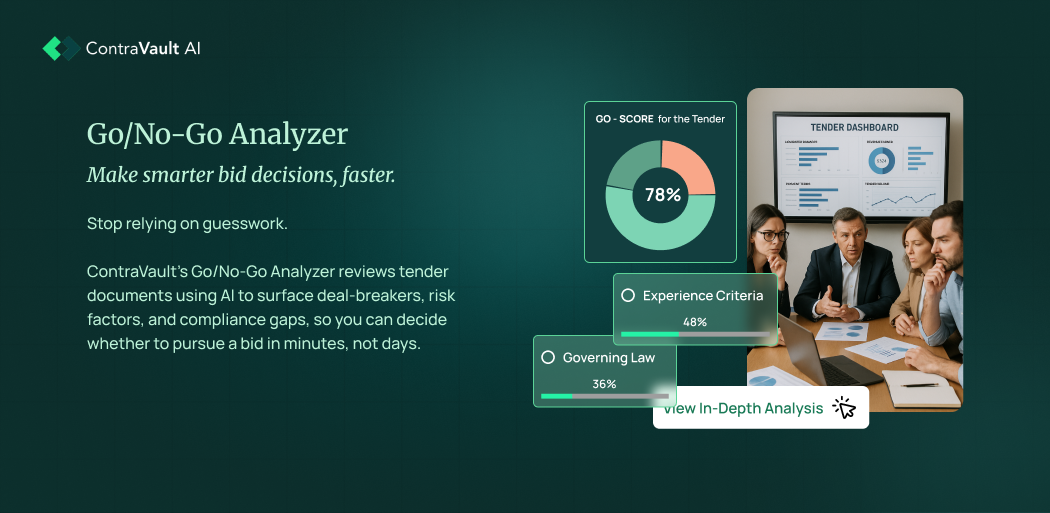
Transforming Tender Management with AI
AI for tenders is proving to be a game-changer by directly addressing the pain points of traditional tender analysis. Instead of poring over pages for days, AI-driven tools can process the same information in minutes with greater accuracy. Here’s how AI transforms tender management:
Accelerated Analysis: AI can read and analyze vast documents at lightning speed. Natural Language Processing (NLP) algorithms digest text and extract key data far faster than any human. This drastically cuts down cycle times – studies show AI can reduce tender evaluation cycle times by up to 80% compared to purely manual methods. In practice, what used to take a team a week of full-time work might be done in a few hours by an AI, enabling organizations to decide on bids sooner and respond to more opportunities.
Enhanced Accuracy and Risk Detection: AI doesn’t get fatigued or overlook details the way humans might on a Friday evening. Machine learning models can be trained to flag anomalies, risky clauses, and contradictions with consistent accuracy. This leads to near-zero missed compliance issues, essentially eliminating the costly human misses that otherwise occur. In fact, procurement teams using automation have avoided roughly 9% of potential revenue losses that stem from human error omissions. By catching red-flag clauses and requirements upfront, AI enables strategic risk management – teams can focus on how to mitigate or negotiate risks instead of accidentally agreeing to them.
Real-Time Compliance Checking: AI systems can be pre-loaded with compliance checklists and regulatory criteria (e.g., ISO standards, eligibility rules, labor laws). They will automatically scan tender documents against these benchmarks. The result is instant identification of compliance requirements and gaps. For example, ContraVault AI comes with over 1,000 pre-built compliance checks for common tender rules. This means no requirement is left unchecked. Businesses can respond promptly to compliance needs, obtaining missing certificates or clarifications well before deadlines. The difficulty of identifying and responding to compliance obligations promptly becomes a thing of the past, as AI highlights them as soon as the tender is uploaded.
Strategic Decision-Making and Higher ROI: By relieving humans of low-level drudgery, AI lets teams focus on strategy – choosing the right tenders to pursue and crafting winning responses. Advanced analytics can even provide a Go/No-Go recommendation by evaluating the alignment of a tender with the company’s strengths and past win patterns. Companies that have embraced AI in tendering report pursuing up to 3× more tender opportunities (because they can handle more) and achieving a five-fold return on investment in their tender processes. Freed from busywork, bid teams can invest time in improving proposal quality, tailoring value propositions, and ultimately increasing their win rates. In short, AI-driven tender management not only cuts costs but also drives revenue, a higher ROI through more wins and better contracts.
ContraVault AI encapsulates all these benefits in one platform. It has demonstrated a 90% reduction in manual review time for its users, meaning what once took a week can now be done in hours. Accuracy is enhanced through AI-driven risk and compliance checks, leading to smarter risk mitigation strategies rather than reactive firefighting. By catching issues early and fast, ContraVault helps avoid the late surprises that derail bids. The result is a tender process that’s not only more efficient, but also more intelligent. In an environment where winning Indian tenders and global contracts are fiercely competitive, such an AI-augmented approach becomes a strategic necessity for CXOs, Directors, and VPs looking to improve outcomes and maximize their resources.
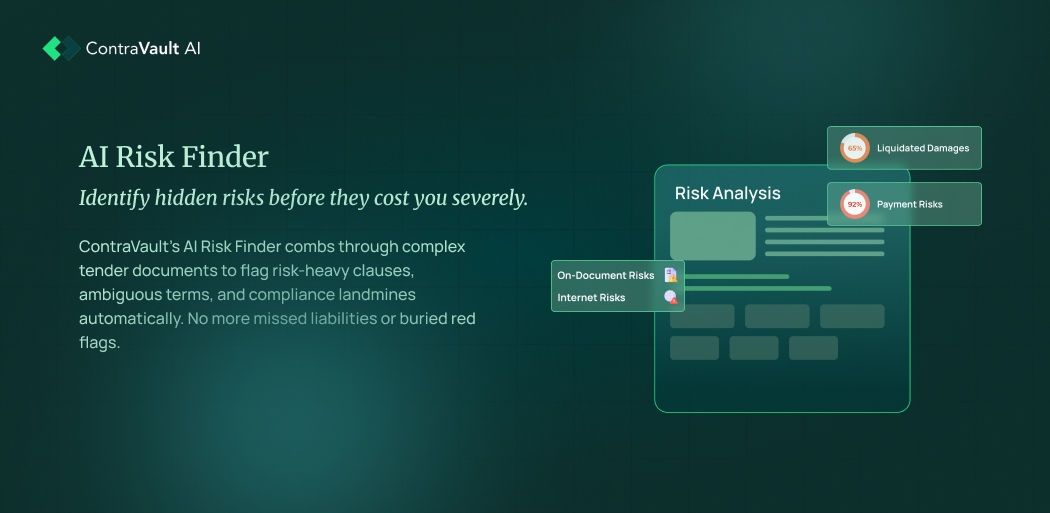
Key Features of ContraVault AI
ContraVault AI brings a comprehensive suite of features tailored to overhaul how organizations read, analyze, and respond to tenders. Below are its key features, each addressing specific challenges in tender management:
Risk Finder: This AI-powered risk detection module is like having a diligent risk analyst comb through every page of the tender. RiskFinder automatically scans documents to identify hidden risks and non-standard clauses, flagging anything that looks unusual or potentially problematic. It goes beyond simple flagging – it provides a visual risk heat map with risk scoring and prioritization. High-risk sections are highlighted (often color-coded) so that your legal and bid teams know exactly where to focus. For each risk identified, ContraVault can even suggest mitigation strategies or recommended actions. This feature drastically reduces the chance of overlooking a “poison pill” clause or contradictory requirement. By quantifying risk levels, RiskFinder enables strategic decision-making – you can decide which risks are acceptable and which bids to avoid or negotiate, ultimately protecting your firm from costly contract pitfalls.
Tender Summarisation: One of the most laborious tasks in tendering is synthesizing a massive document into an executive summary for decision-makers. ContraVault AI’s Tender Summarisation feature creates instant, structured summaries of tender documents, tailored to what your business needs to know. Instead of wading through legalistic text, you get a concise overview covering key sections – scope of work, deadlines, major obligations, eligibility criteria, etc. The summary can be customized (for example, a CFO might want financial obligations highlighted, while a technical lead cares about specs and standards). This AI-generated synopsis is available within seconds of uploading the tender. No more sifting through pages of legal text – just the key insights you need, saving your team many hours per tender. These summaries enable busy executives to grasp a tender’s gist quickly and make informed decisions (go/no-go or resource allocation) without delay. Moreover, since the summary is generated by AI consistently, it ensures that nothing important (like a liquidated damages clause or an unusual warranty requirement) is accidentally omitted in the overview.
Go/No-Go Analysis: Deciding whether to bid on a tender is a strategic choice – chase too many and you stretch resources thin, but skip too many and you lose opportunities. ContraVault AI’s Go/No-Go Analysis uses AI to evaluate compliance requirements and strategic fit rapidly, helping teams make informed bid/no-bid decisions. The system cross-checks the tender’s criteria against your company’s profile (certifications, experience, technical capability, financial capacity, etc.) and highlights any gaps or deal-breakers. It essentially performs an accelerated compliance check and risk assessment to indicate if the tender is a good opportunity or a high-risk venture. By surfacing all the key factors (e.g., “90% compliance match, but missing ISO 14001 certificate” or “Scope aligns with past projects, but timeline is very aggressive”), ContraVault AI gives your bid committee a factual basis for their decision. This means you can decide in minutes, not days, whether a tender is worth pursuing. Companies leveraging this module have been able to increase the number of tenders they bid on (since low-fit tenders are quickly filtered out, freeing time for better opportunities) and improve their win rate by focusing only on the bids they have a strong chance of winning.
AI-Powered Contextual Search: Large tender documents make it hard to find specific information when you need it. ContraVault’s contextual search solves this by allowing you to query the tender document in plain language – the AI will retrieve the exact sections or answers you need. For example, you could ask, “What is the performance guarantee period?” or “Find references to payment terms,” and the system will pinpoint the relevant clauses. This is not a simple keyword search; it uses AI to understand context, so even if the exact wording differs (e.g., “warranty period” vs. “guarantee”), it will find it. This quick, contextually accurate search saves tremendous time for users. Instead of manually hunting through a 300-page document for a particular clause, you get an immediate answer. It’s like having a smart assistant that has read the entire tender and can quote it on demand. In the heat of proposal preparation or in a clarification meeting, this feature is invaluable to confidently and rapidly retrieve facts from the tender.
Pre-Bid Query Generation: Seeking clarifications is a normal part of tendering, but formulating the right questions to ask the tender issuer can be challenging and time-consuming. ContraVault AI can automatically identify areas of ambiguity or concern in the tender and draft client-ready pre-bid queries for you. For instance, if a requirement is unclear or two sections appear contradictory, the system will flag it and suggest a polite, precise question to get clarification. This ensures you don’t overlook the need to ask something important (which could later turn into a costly assumption). It also saves your team the effort of composing these questions from scratch. By submitting well-crafted queries, you not only reduce negotiation risks later (fewer surprises post-award) but you also demonstrate professionalism to the client. This feature is especially helpful for businesses new to certain markets or those dealing with tenders in foreign languages – the AI can bridge understanding gaps and ensure you get the clarity needed to bid confidently.
Contradiction Finder: Tender documents often have multiple sections compiled from different sources, which can inadvertently lead to conflicting statements (for example, technical specs vs. general conditions). ContraVault AI’s Contradiction Finder uses AI to spot inconsistencies and contradictions within tender documents. If one clause says one thing and another clause negates or conflicts with it, this tool will highlight both and bring them to your attention. This is something human reviewers frequently miss, especially under time pressure. Identifying contradictions is critical – it allows you to seek clarifications or at least internally reconcile how you will address the discrepancy in your bid. By catching these, ContraVault AI helps minimize the risk of oversight that could otherwise lead to compliance issues or disputes later. It essentially sanity-checks the document for you, ensuring that your interpretation of the requirements is based on a consistent understanding of the tender.
Form Extraction Tool: Anyone who has filled out tender forms knows how tedious it can be to extract information (like filling in a bill of quantities, vendor detail forms, etc.). ContraVault AI’s form extraction tool can intelligently read and pull data from forms and tables embedded in tender PDFs or documents. Instead of manually copying values or retyping information into your bid templates, the AI will capture that data and organize it for you. This significantly enhances data accuracy and accessibility – numbers and facts are less likely to be transposed incorrectly when an AI is handling them. It can populate your internal databases or bid response forms directly with the extracted data. The efficiency gains here are huge: what might take hours of dull copy-paste work can be done in seconds, with the added benefit of reducing human error. Throughout a large bid, this tool ensures you don’t miss a required field (because the AI doesn’t get tired and skip a line) and that all critical data from the tender is accounted for in your response kit.
Each of these features works in concert on a single platform, turning tender management from a laborious chore into a streamlined, intelligent process. With ContraVault AI handling the heavy lifting of analysis, your team can focus on strategy, pricing, and creativity – the human elements that win bids. This feature-rich approach gives companies a competitive edge, whether they are navigating complex GEM tenders on India’s Government eMarketplace or large eProc tenders internationally. The next section discusses how having all these tools unified in one platform further amplifies these benefits.
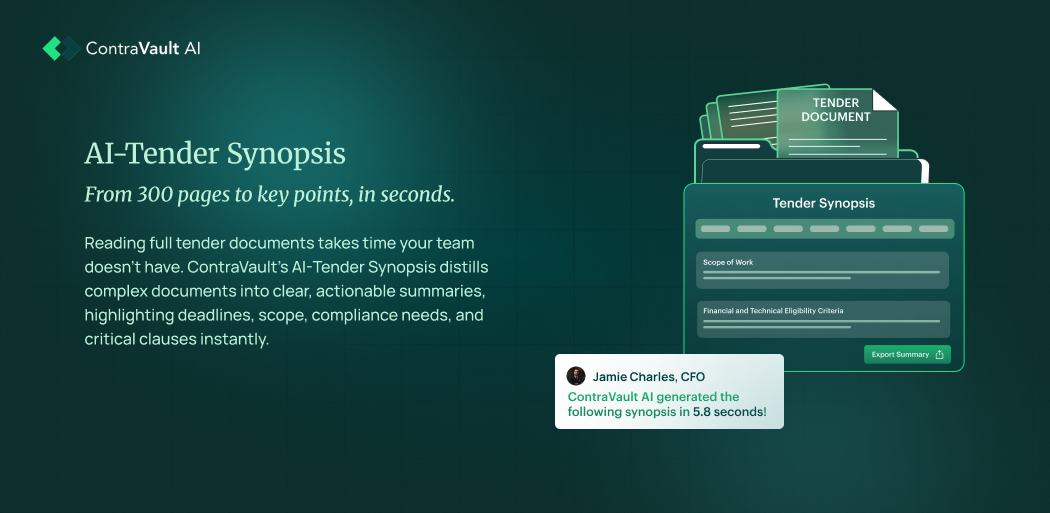
Serving Emerging Markets and Key Sectors
While ContraVault AI provides value to organizations worldwide, it has a special significance for businesses in emerging markets like India and sectors such as construction, manufacturing, and government contracting. These contexts often involve unique challenges that ContraVault is well-positioned to address:
Empowering Emerging Economies: In developing markets, companies may face resource constraints and a steep learning curve in navigating large-scale tenders (especially government RFPs with exhaustive requirements). ContraVault AI levels the playing field by equipping even smaller firms or first-time participants with world-class tender analysis capabilities. For example, Indian tendering companies can leverage AI to instantly interpret complex requirements in a Government of India tender, something that might have required hiring expensive consultants in the past. The platform’s support for 90+ languages is also a boon in markets like India, where tenders might include regional languages or where businesses are pursuing opportunities abroad. This means a company in India can confidently bid on a project in the Middle East or Europe, with ContraVault translating and analyzing the tender documents seamlessly.
GeM and E-Procurement Synergy: India’s Government e-Marketplace (GeM) and various e-procurement portals have digitized tender publication and submission. However, even as these GeM tenders and eProc tenders move online, the challenge of analyzing the tender content remains. ContraVault complements these initiatives by taking the digital tender documents from portals like GeM and running all the aforementioned AI checks on them. Given that India’s central and state governments procure about $71 billion annually through GeM, the volume of opportunities is enormous. ContraVault helps businesses tap into this volume by swiftly processing each tender and identifying which ones are feasible and competitive for them. Whether it’s a small supplier trying to navigate a public sector undertaking (PSU) tender or a mid-sized contractor looking to expand into new states, the AI platform provides the insight needed to bid smartly rather than shooting in the dark.
Construction and Infrastructure: The construction sector is notorious for large tender documents (sprawling technical specifications, drawings, BOQs, contract conditions) and tight deadlines. Even established construction firms can struggle with the sheer effort needed to parse everything. ContraVault AI shines here by quickly summarizing complex technical sections and flagging onerous contract terms (like liquidated damages or performance security requirements) that are common in construction tenders. By doing so, it not only saves time but also prevents mistakes that could erode profit margins later. The RiskFinder and Go/No-Go features are particularly useful in construction, where taking on a high-risk project (e.g., with unbalanced contract terms) could be disastrous. Early users in construction have noted significantly faster bid preparation and more competitive bids, directly attributable to AI-driven analysis.
Manufacturing and Industrial Tenders: Manufacturing companies often deal with tenders that have exacting technical compliance sections and numerous standards to adhere to. Missing one specification or misreading one clause can mean a non-compliant bid. ContraVault AI’s Go/No-Go Analyser ensures that all technical and regulatory requirements in the tender are verified. For instance, if a tender requires compliance with a certain Bureau of Indian Standards (BIS) code or an international standard (ISO, ASTM, etc.), the AI will spot it and alert the team to include the proof or certification. In industries like pharmaceuticals or heavy engineering, where documentation is key, the form extraction and summarization tools help teams keep track of every requirement and prepare the needed documents in an organized way. The result is a more confident bid, where the company isn’t second-guessing whether they missed a detail.
Government and Public Sector Contracts: Public tenders typically involve strict processes, numerous forms, and are subject to audits. For CXOs and Directors in these sectors, ensuring a fully compliant and polished bid is paramount, as is maintaining a clear audit trail of how the bid was prepared. ContraVault AI helps on both fronts. It not only catches compliance issues (as discussed, leading to fewer rejections – remember that ~30% stat of bids failing due to compliance in India ), but it also records the analyses done. If ever questioned, you have an AI-generated report of risks identified and clarifications sought, which demonstrates diligence. Additionally, in sectors like defense or energy, tenders can include classified or highly sensitive data; ContraVault’s robust security (SOC 2, etc.) ensures these are kept confidential while being analyzed. This gives emerging market firms the confidence to engage in big-ticket government projects that they might have shied away from before, due to fear of making an error in the complex bidding process.
Across these examples, a theme emerges: ContraVault AI supports businesses in taking on more tenders and competing more effectively, regardless of their size or current capabilities. It brings sophisticated tendering practices (the kind usually seen at large multinational corporations) within reach for companies in India and other growing markets. By doing so, it contributes to a more level playing field – contracts can be won on merit and preparation, not just on who can throw more manpower at reading documents. Sectors like construction, manufacturing, and government contracting stand to gain significantly from this democratization of tender expertise. The platform’s early adoption in India has already shown promise, with users reporting faster tender turnarounds and higher success rates in their bids. As emerging economies continue to invest in infrastructure and development, tools like ContraVault AI will be key allies for companies aiming to secure those projects.
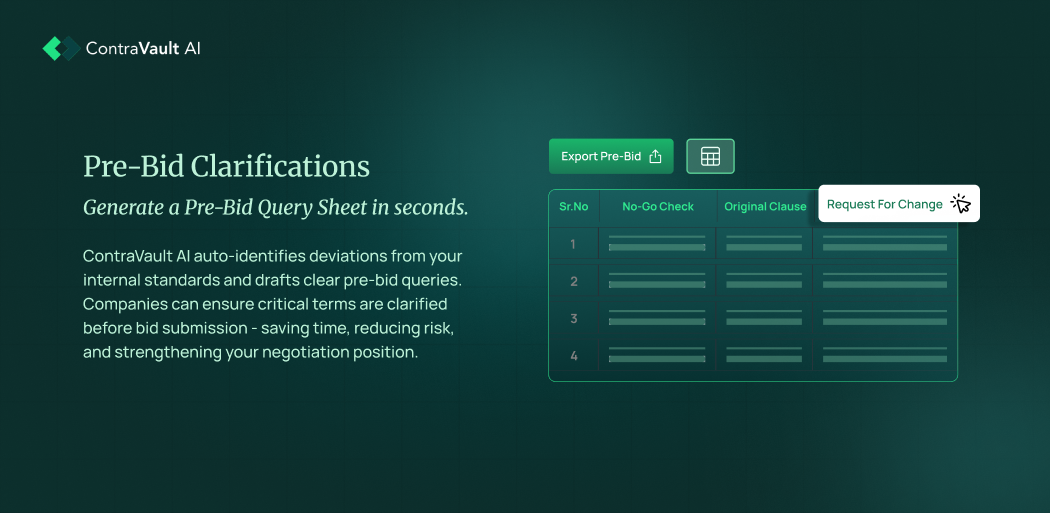
Conclusion
In an era where every competitive edge matters, ContraVault AI offers a transformative approach to tender management. It directly tackles the traditional challenges of tendering – from time-intensive analysis and human error to compliance complexities – by leveraging cutting-edge AI. The result is a tender process that is faster, smarter, and more reliable. For CXOs, Directors, and VPs overseeing bid teams, the platform delivers not just efficiency but strategic clarity: your team can focus on winning tenders rather than wading through paperwork.
The ROI is evident – with up to 90% time savings and significant improvements in bid success rates reported – and the qualitative benefits (like reduced stress on employees and better risk control) are equally valuable. Moreover, ContraVault’s unified platform and strong security posture mean these gains come without introducing new operational silos or security risks. On the contrary, your tendering becomes more streamlined and secure.
Whether you’re looking to dominate Indian tenders or expand globally, embracing AI in tendering is rapidly becoming best practice. ContraVault AI stands out as a specialized solution tailored for this domain, incorporating industry expertise and AI prowess. It is not just a tool but a strategic partner in navigating the complex world of RFPs, GeM tenders, and contracts. By choosing ContraVault AI for tender analysis, organizations position themselves to bid more confidently, manage risks proactively, and ultimately, win more tenders in a sustainable, efficient manner. The tendering landscape is evolving, and with ContraVault AI, businesses can lead that evolution rather than be left behind.